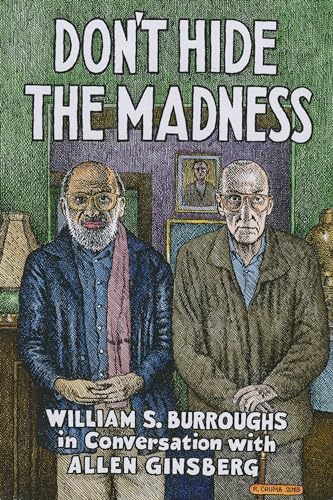Don't Hide the Madness: William S. Burroughs in Conversation with Allen Ginsberg

“a conversation loaded with details, ideas, analyses, and a profound understanding of a moment in American literary history and the people who lived it.”
What do you talk about when you’re two cultural icons, two demons of creativity, two of the leading literary lights of a generation that refocused the cultural lens of America?
What do you talk about when you’re not onstage delivering the lines that fix you in the intellectual firmament or reading from the books that seem to originate somewhere in the deepest part of a mind that sees the world in a way no one has imagined before?
Well, it seems that William S. Burroughs (WSB in the transcript) and Allen Ginsberg (AG in the transcript) talk about everything.
They talk about farm raised chickens and murder; they talk about a catatonic cat and Kerouac; they talk about hashish and Tangiers; they talk about Sarah Teasdale and Edith Sitwell; they talk about Paul Bowles and Jane Bowles and a literary universe in flux; and they talk about biomorphic typewriters and one of the most infamous movies ever made—The Naked Lunch.
This is a conversation, but it is more than two men on a speed-rap jag. The temptation for the reader is to go beyond the conversation or to read into it what is not there. The rewards, however, are rich if you stay home and listen to what they are saying. Everything they know is poignant and accessible, and they are afraid of nothing.
If you listen, you hear a deep discussion of sin and how anger is the worst sin and you see this follow from the discussion of sin:
WSB: "You know how rich people hate to lend money or give money to somebody. The richer they are, the stingier they are.” It’s clear that Burroughs doesn’t think about normal very much but his vision and understanding of postindustrial society is complete when he sums up pride—
WSB: “But also all forms of nationalism are manifestations of pride.” It is this kind of thinking that gives us Queer and Wild Boys.
Ginsberg’s take on anger is equally enlightening:
AG: “Oh no, the thing is to take an inquisitive, curious interest in anger. . . . But the question that the Tibetans make is of simply noticing it (anger). In fact their view is you don’t have to do anything about it. All you have to do is notice it. Because adding the dimension of noticing the anger immediately evaporates about 80 percent of the heat and the pus.” (sic)
This book, this hours long conversation, gives us a look at Burroughs and Ginsberg in relaxed mode. Under no pressures to perform, without time limits, we see two men opening their minds in ways that are at once deep and gentle, in ways that show their intimate knowledge of one another.
One especially interesting section comes late in the conversation when AG and WSB discuss Burroughs’ “failed analysis” and how it relates to Burroughs’ experience with the Shaman who exorcised the Ugly Spirit that had control of Burroughs when he shot and killed his wife, Joan:
WSB: “This you see is the same notion or same…exorcism, psychotherapy, Freudian psychotherapy, shamanistic practices, getting to the moment when whatever it had gained access. And also the name of the spirit. Just to know that it’s the Ugly Spirit. That’s a great step. Because the spirit doesn’t want its name to be known.”
As you read this conversation, it’s important to set aside expectations and to accept the transcript for what it is—a conversation, but a conversation loaded with details, ideas, analyses, and a profound understanding of a moment in American literary history and the people who lived it.